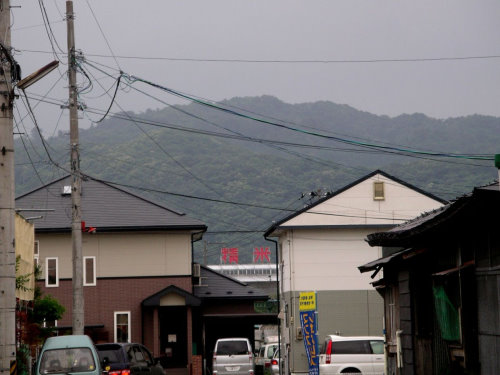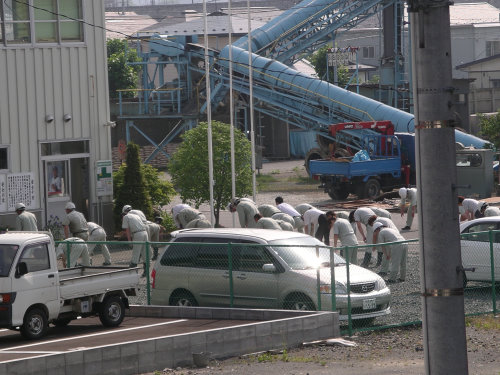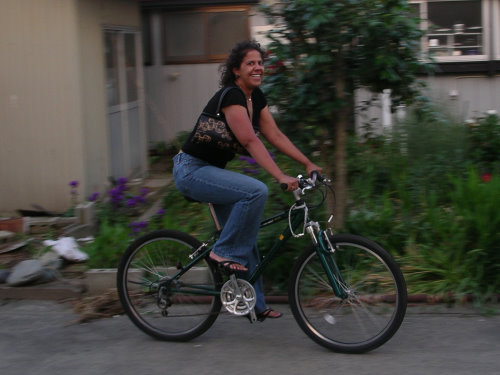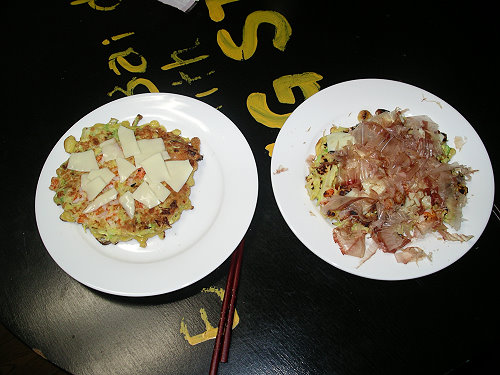So, we've rented a car (a Nissan Cube -- it's so cuboid!) for the occasion. We plan to hit the Tohoku Expressway bright and early tomorrow morning, en route to Narita via Tokyo. I took a practice (well, sort of) drive this afternoon and had the pleasure of listening to the "Max Wavescape" program on FM-Iwate. It totally sounded like one of the fake radio stations from the "Grand Theft Auto" games, with the hyperactive interviews, hip-hop/dance tunes, and the whole "YOU'RE listening to FM-Iwate. Here's the new song, 'Peace of Mind', by Sakura." Except in Japanese.
So, we've rented a car (a Nissan Cube -- it's so cuboid!) for the occasion. We plan to hit the Tohoku Expressway bright and early tomorrow morning, en route to Narita via Tokyo. I took a practice (well, sort of) drive this afternoon and had the pleasure of listening to the "Max Wavescape" program on FM-Iwate. It totally sounded like one of the fake radio stations from the "Grand Theft Auto" games, with the hyperactive interviews, hip-hop/dance tunes, and the whole "YOU'RE listening to FM-Iwate. Here's the new song, 'Peace of Mind', by Sakura." Except in Japanese.

Even on a day during which the sky has turned as stormy as this one, this sight makes me inexplicably happy. It may have something to do with the fact that few things say "I live in Japan" like neon signs in kanji. That's our house on the right, the utilitarian gray-and-white one that sort of looks like it's made of Legos.

Actually, having an exercise routine built in as part of your work day might not be a bad idea. The Japanese people are traditionally pretty healthy, and this kind of health program has surely contributed.

Yes, Mona, it's the MoojooKen bag. Word of caution: heels as bike footwear can lead to catching on your pedals, which in turn can lead to falling over in parking lots. Or so I'm told.

Tabemashou! Let's eat!

In Japan, it is considered good luck to see a spider in the morning, and bad luck to see one at night. Alas, there seem to be many spiders around our house that come out only at night! Almost every window has one of these guys there to catch any small insects attracted by our lights.
He (she?) wouldn't sit still to be measured, but I estimate it's about 2cm (3/4 inch) across, including the legs.
So it was to my surprise, and another person's amusement, that it came out quite naturally in conversation. We were standing in a group where someone was passing out sheets of paper printed in Japanese. She was handed one, I was not; perhaps it was intended that we share. I looked over at her sheet and asked:
"Nan dabe."
She giggled in surprise, and explained that it was lyrics to the song that was about to be sung. I later overheard her telling her husband about my question. I think we're going to fit in just fine.
A: They all have lovely bridges. Also, I've gotten lost there.
Whatever changes living abroad will bring, being able to orient myself geographically is unlikely to be one of them. Doesn't matter whether I have a map, doesn't matter whether there are recognizable landmarks. As anyone who's ever depended on me for directions knows, I can't find my way out of a paper bag. I blame my brother, who apparently got all the navigation genes.
With this knowledge, I optimistically set out on my bike for a nice long workout ride. I crossed the Waga River via the New Kunenbashi Bridge to check out more of the other side of Kitakami. I rode up hills, past pachinko parlors, gardening stores, and rice paddy upon rice paddy, whizzing by green mountains and Buddhist shrines. As the sun began its descent behind the peaks to the west, I turned for home. Because I was returning via a bridge that Matthew and I had crossed in reverse earlier in the week, I felt comfortable that I knew my way home. After passing a recognizable landmark, I decided that I would turn earlier and explore a new, but parallel, route home.
Oh, if only.
Pleased with my expeditionary streak, I pedaled past more rice paddies, small houses, and convenience stores until I came to...the shinkansen tracks.
Huh? I shouldn't reach the tracks before I reach home. Actually, I shouldn't reach them at all. Confused, I turned in the direction that I thought would lead home, which turned out to be a small farm road between rice paddies. However, the elevation of the road allowed me to see the Hotel City Plaza Kitakami and the neon kanji of the cement plant beyond the shinkansen tracks. Ah! Home was that way. I just needed to get to the other side of the tracks.
I rode back out to the main road, turned right under the tracks, and down a major road with almost no shoulder. It was late enough in the afternoon that rush hour was well underway, and even though Japanese drivers are respectful of cyclists, I was still pretty uncomfortable riding on this road. At the earliest possible time, I turned, hoping to find a less busy road home.
Instead, I was soon surrounded by rice paddies, which were bordered by what appeared to be a high embankment. Yes! If this were the embankment of the Waga River, I could simply follow the road home. Because it was not the embankment of the Waga River, I could simply follow the road between the two vast expanses of rice paddies and greet the chatty neighborhood rice farmers with a fast bow and a reasonably controlled "konnichiwa." Until it ended, at which point I would have to go back to the busy road and back under the tracks.
Up to this point, I had managed to keep my innate skepticism in check by reasoning that I knew where the sun was, which at that point in the day marked west. Also, I had managed to orient to the shinkansen tracks, so if I could just guide from them, I could get home. I would solve this problem.
Assistance came in the form of the first sign I saw. The sign, in Japanese, pointed the way to the Sakurano shopping center in Central Kitakami. Ahh...direction. Home was not far. I could live with the cars flying by on my right as I rode with traffic, watching the tall pink top of the Sakurano draw nearer. The shoulder narrowed further, the road wound through a more populated area, and a bridge loomed ahead (?), marked by a slightly rusty, faded sign announcing its name.
Kunenbashi.
As I stood with my bike in the five-foot-tall weeds growing along the side of the road waiting for the rush hour traffic to clear enough for me to cross to the side of the bridge with the clank-clanky deathtrap bike path, I realized that I had never crossed back over the river. I incorrectly remembered the location of the landmark. And now, my contentedness at successfully bringing my inadvertent adventure to a close was tarnished by two things: the realization that although I'd achieved my goal of finding a "parallel way home", I'd had no effing clue where I was; and the specter of Kunenbashi ahead.
Damn you, Kunenbashi.
1/4 oz. Sweet Vermouth
Dash of bitters
Shake ingredients with cracked ice in a cocktail shaker. Pour into a chilled cocktail glass and garnish with an awful maraschino cherry (or substitute a decent maraschino cherry if you can get one).
This drink is basically a Rob Roy made with Japanese whisky instead of Scotch. It is named after a famous writer who was born in Hanamaki, the next town over. People in this area are quite proud of Miyazawa's heritage here. More information about Miyazawa Kenji can be found on the internet.
The name is not particularly tied to this cocktail; we just chose it because we thought it should be named after a famous Japanese (as the Rob Roy is named after a famous Scot), and decided that Miyazawa gave it some local flavor.
Additionally, there's the matter of the house. Take the kitchen. The kitchen in our house in Maryland isn't spacious by any stretch of the imagination, but it does take up more than the width of one short wall in a room. And speaking of short, I'd like to pitch an idea to all the inventors out there: Hydraulic Kitchen. Matthew and I are of different enough heights that a standard 3-foot-high American kitchen counter is dandy for me, but too low for him. The 2-1/2-foot-high sink and cooktop in our Kunenbashi kitchen are backbreaking for him (he's allegedly knelt to work at the sink) and uncomfortable for me. Hydraulic Kitchen could easily solve these problems by allowing the user to adjust the height of the kitchen workspaces to his or her needs, then return them to the standard height after use. Added benefit: you can raise the appliances for easy floor cleaning.
Please contact me for instructions on where to send the royalties.
The side benefit of Hydraulic Kitchen becomes apparent when you consider the nature of dust here in the 'Bash. We leave the windows open most of the time because we don't have central A/C, which is not uncommon in Japan. You might imagine that a certain amount of dirt blowing in through the screens would be normal, and in fact, it is. We're stumped by the Swiffer(tm)-loads of lint that we pick up every day. Like, a washcloth worth of lint. As best we can figure, our socks are the major contributors. Or maybe something about the Jetsons washer/dryer renders our clothing exceptionally linty. In any event, lint as dust = confusing to desert rats.
Ooh, Matthew just came home with his dry cleaning and a bag of maple buns. *angels sing* Maple buns are some of the best things about Japan.
For anyone keeping track of gifts, yesterday's trip to the post office garnered a postcard masquerading as a fan. Good luck sending that through the US Postal Service.
Back Next
 Calendar
Calendar




